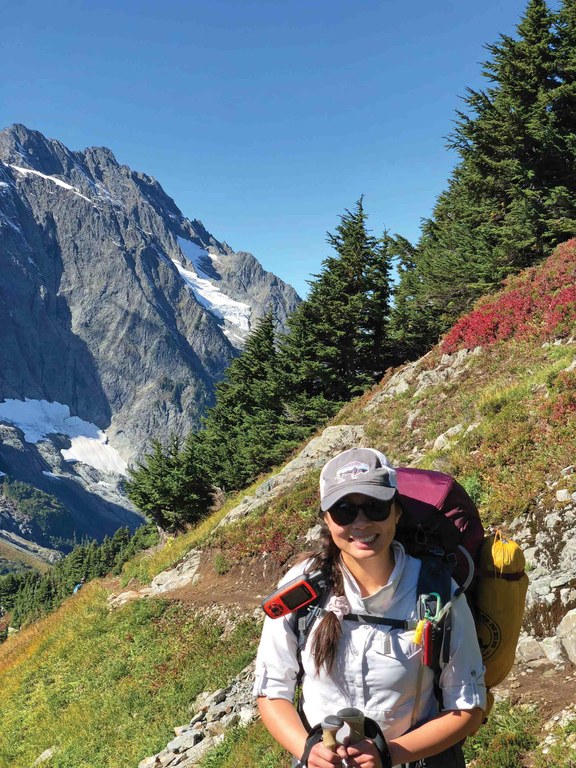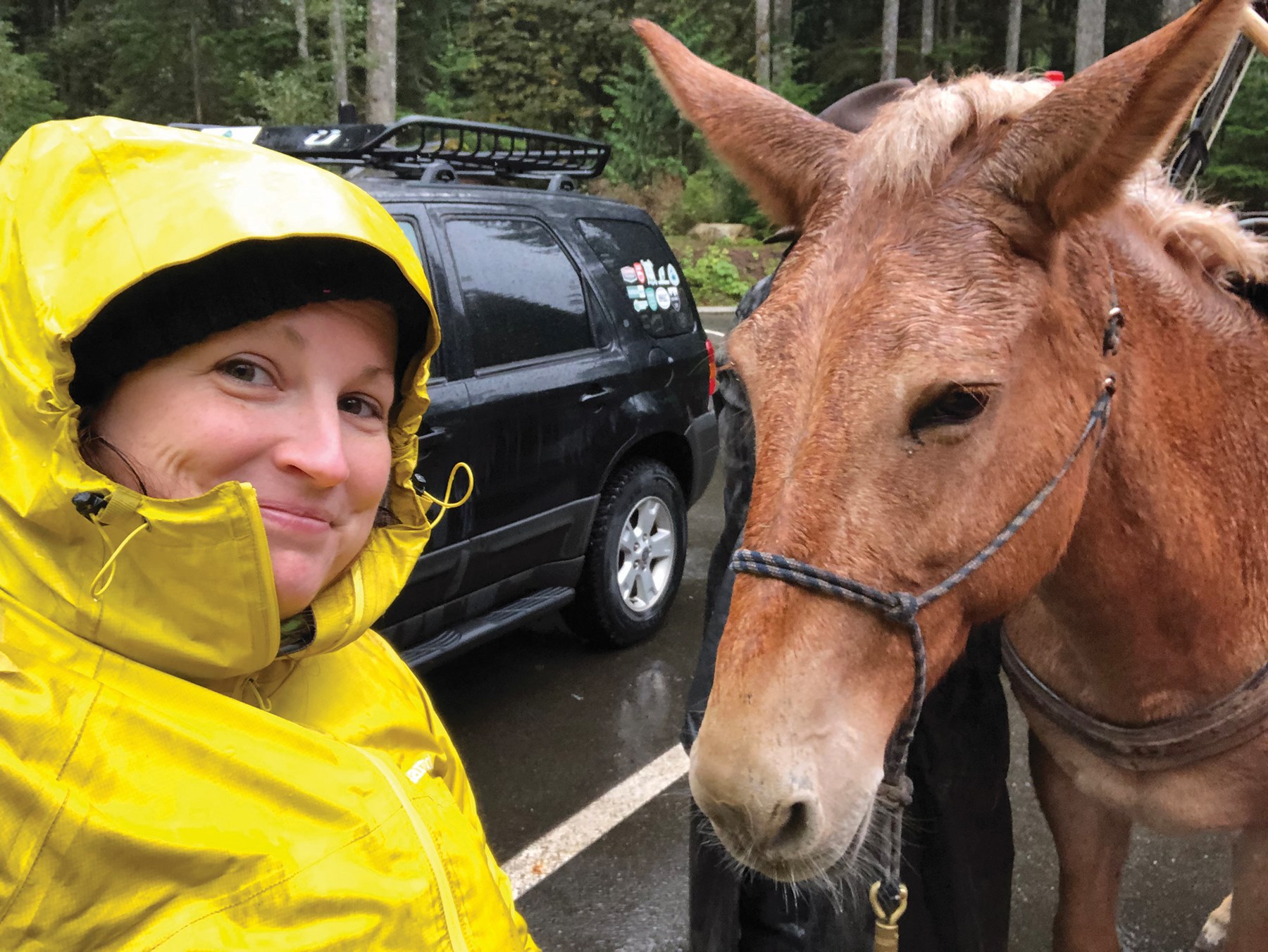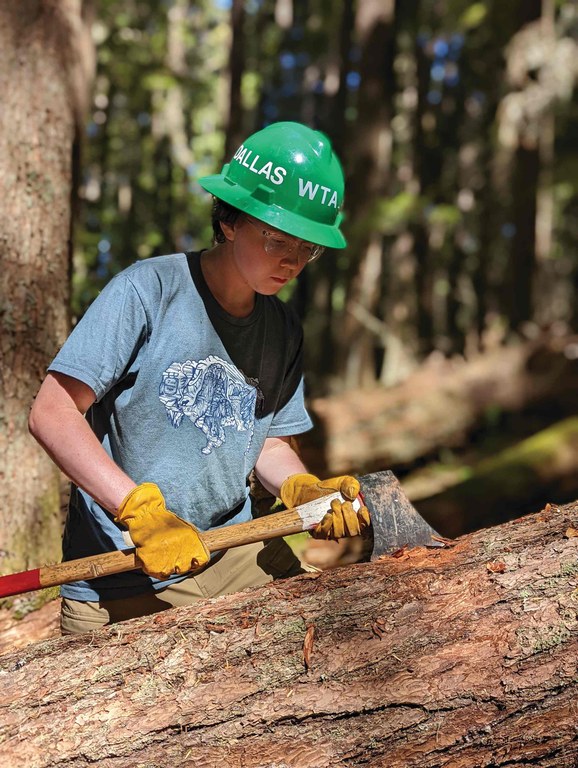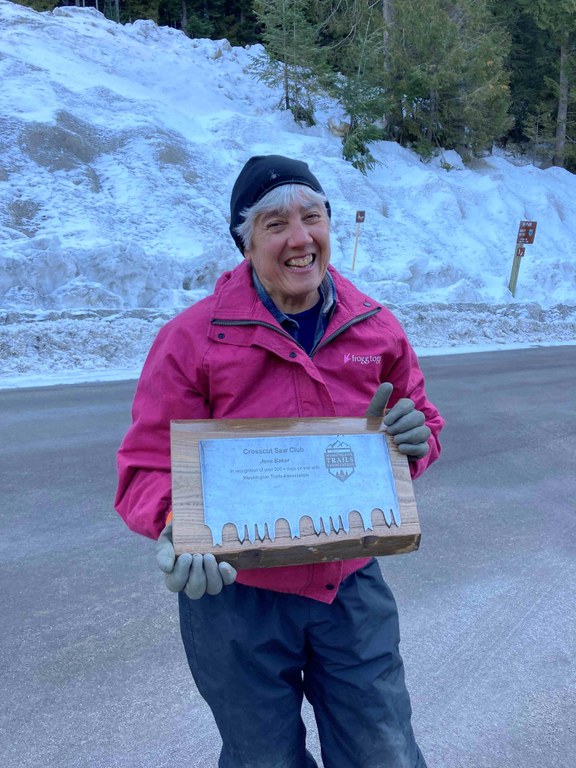 Washington Trails
Association
Washington Trails
Association
Trails for everyone, forever
Five WTA volunteers share how their time on trail has brought them community, skills and confidence.
Just as our beloved Washington trails are shaped by WTA volunteers, volunteers are shaped by their experiences on trail. Whether finding a sense of belonging and making new friends, developing skills that translate off-trail or gaining confidence in their work, volunteers across the state have found that their experiences provide them with more than just a day spent on trail.
We asked those volunteers to tell us their stories.
For years as a Washington state resident, I relied on the WTA website for trail information and trip reports. About 5 years ago, I joined my first WTA work party to repay a little of what I had gained. After the first day, I was hooked. It was great fun to “work" outdoors, a refreshing change from my exclusively indoor and highly academic profession. I have been volunteering with WTA in various capacities since. I believe in WTA’s mission and values — which parallel my own — and its impact on my community.

Whitney’s relationship with trails has evolved over the years. Now, she’s not only a trail user, but also a volunteer trail maintainer, advocate and ambassador. Photo by Whitney Allar.
WTA strengthens my connection to my community. I have met like-minded people who enjoy hiking, backpacking, cycling and Nordic skiing who have become dear friends. I can also help those who are new to outdoor activities. My volunteer work with WTA has taught me how to connect with those individuals and to help foster their romance with the outdoors — including by directing them to WTA resources. And, for those wanting to get involved, I can introduce them to tangible ways WTA makes it possible to be a champion for trails.
Nowadays, I am a WTA ambassador. I attend outreach events in my Eastern Washington community, I do trail work on single-day and multiday trips, and I participate in advocacy work to ask our lawmakers to preserve and maintain public lands.
Seeing young families, dog owners, beginner hikers and serious trekkers all on trail reminds me to celebrate what we have in common. We Washingtonians are so fortunate that the next hike is in our neighborhood or a reasonable drive away.
Volunteering with WTA allows me to share my love of the outdoors in a meaningful way. I get to be outdoors and swing some tools to help build a brand-new trail or to revitalize a beloved existing trail. Learning a little about the expertise, collaboration and labor that go into building a trail has greatly enhanced my own appreciation for trails. It is wonderful to be a small part of something good.
I signed up for my first work party, at the Old Sauk River Trail, about 6 months after moving to Washington. I was looking for ways to meet people with outdoorsy interests. I used a crosscut saw that first day. I hadn’t thought I’d get to touch the giant saw, but I did. I was stoked as a woman to be doing things that were out of my comfort level.
I was hooked.

Karen likes being part of a tight-knit community. And on some of her work parties, that community even includes pack animals! Photo by Karen Bean.
Working with WTA has helped me see small details. It’s not about quantity, it’s about quality. Building structures, using a crosscut saw, developing trail eyes — working with WTA has shown me the complexity that goes into creating and maintaining trails. It has also helped me take pride in my work, not just on trail but in everything I do, and to push myself in ways I didn’t know I could. It changed my perspective. I didn’t really have pride in what I did at my job — it was just what I did. I didn’t think I had special skills, but trail work helped me realize that what I do — on and off trail — is special. I now talk about my work more and take pride in what I create as a photographer and museum digitization specialist — I’m saving history for future generations.
Now, I’m a WTA volunteer crew leader and assistant crew leader. I am almost 275 days deep into volunteering. I have a couple of really good friends I’ve made through WTA that I hike with, hang out with and confide in. They understand my need to be out in the woods getting dirty!
WTA helped me find myself here. It gave me a community and a purpose. I want to help keep the outdoors accessible to everyone.
I started using the WTA website when I was looking for hikes and checking trail conditions, and soon learned about WTA’s volunteer opportunities.
I was also looking into colleges at the time and had learned that they like seeing volunteer work. I decided to volunteer with WTA because I wanted to help trails because of how often I use them.

Dallas signed up for his first trail work party for some volunteer experience last year. Now, you’ll find him at a trail work party almost every weekend — sometimes even twice in one weekend. Photo by Zachary Toliver.
My first work party was a youth volunteer vacation last July. Volunteering has changed my perspective on how things get done on trails. It takes days to finish even short sections of complicated trails. It’s also shown me how things get done a lot faster when everyone is working together.
Working with WTA has helped me develop collaborative and critical thinking skills, especially when our crew has to work together to problem solve.
Last year, my crew was building stairs at Snow Lake and we were trying to get a huge rock out of the ground. We started digging and discovered there were actually two really large rocks, one over the other, with a stump holding them into the ground. They were way too large to move alone, so the task required really good collaboration and communication between members of the crew.
Although I expected to gain trail work skills with WTA, I was surprised to gain leadership skills too. I expected that volunteering would mostly be getting told what to do. As I’ve gained experience, I’ve started telling others what they can do, too. I’ve taken on leadership roles, like when I’m working with kids or when I’m the most experienced on a type of project.
Now, in groups at school, I’m able to lead and help everyone figure out what to do.
I’ll be heading off to college soon and I’m thinking of leaving the state to try something new, but I’ll miss working with WTA if I do!
I moved to Spokane from the Midwest in 1984 to be near the mountains. I began doing service trips with the Sierra Club in 1987 and I really took to trail work — it kept me fit, connected me to the wilderness, let me meet great people and gave me a way to make a difference in my community.
I found WTA in 2005 after my boss showed me the website. I was delighted to discover volunteer vacations. “You mean there’s a trail work organization right here in Washington that has wilderness trips to gorgeous places that take only one week so I can get the time off?” I signed up for one right away.

Jane is not only a member of WTA’s Crosscut Saw Club — made of volunteers who have completed over 500 trail work days — but she was integral in starting up the volunteer program in Eastern Washington. Photo by Holly Weiler.
When I became an assistant crew leader, I wanted there to be more trail work opportunities in Eastern Washington. When I was asked to become a crew leader, I felt too new but realized that role was necessary for the program to be successful here. I asked myself, “If not now, when? If not me, who?”
With that in mind, I became a crew leader in 2009 and helped start WTA’s Eastern Washington volunteer program. The work we have done, the places we’ve been and the people we’ve met have made it worthwhile. There is almost no park or trail around Spokane that we have not touched. We have taken trails in bad shape and made them the best. We have built miles of new trails that have opened up outdoor recreation for an ever-increasing population of nature lovers.
I’ve taken part in over 550 work parties. The best days are when I can teach and share what I have learned — in the best office ever. I respect WTA’s culture of learning, following sustainable trail practices and honoring volunteers. I have been appreciated and respected. When I lost my personalized handsaw — awarded to volunteers who complete 50 work parties — WTA presented me with a brand-new saw shortly after.
I still remember my first day with WTA. It was a volunteer vacation, and the packers had mistakenly dropped our supplies over a mile away from camp. After a little problem solving, we spent the day schlepping supplies. It was a grueling start, but I quickly learned about the resolve, toughness and good-natured humor of WTA volunteers.
The state of Washington is blessed with thousands of these people: WTA volunteers who love the beauty and inspiration of our wild places and are willing to give their time, energy and knowledge to keep our trails open for everyone. It has been a privilege to be one of them.
I discovered WTA when I chose to get involved on National Trails Day in 1998. I tried a few work parties with Greg Ball, WTA’s former executive director — it was his idea to connect hikers directly with stewardship of our trails. His enthusiasm was contagious and I've been active ever since.

Ken joined his first work party 25 years ago — since then, he's spent nearly 700 days with WTA on trail. Photo by Ken Vandver.
Working with WTA fostered leadership skills and emphasized the importance of safety, camaraderie, and — most of all — teamwork. It allowed me to return to backpacking, something I had done solo many years before. While protecting our trails and nurturing the natural beauty of Washington, I like to tell WTA newcomers that they'll never view a trail the same way again, knowing what's involved.
I retired my blue hat at the end of last year, and my wife and I moved to Ashland, OR. But WTA is deeply special to me and I continue to stay active by signing up for BCRTs and other work parties. It is heartening to see good friends and to carry on the good work in the WTA family.